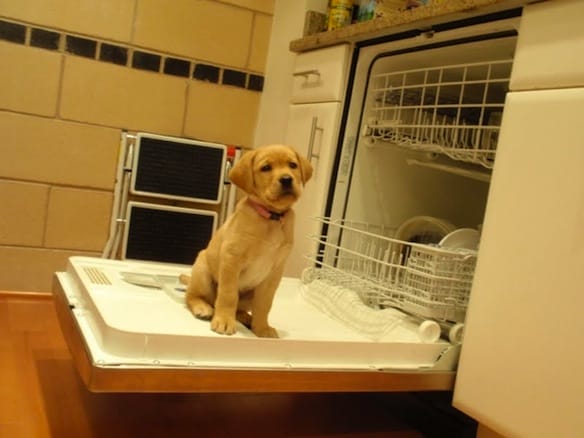
Image credit: MediaBistro.
A Dishwasher Insider
It’s not just an alliteration, it’s a simple truth: Dirty dishes are disgusting. W hat’s even more cringe-worthy is to go into your dish-drying rack (if you still wash dishes by hand) or your dishwasher for a clean dish or glass, and find that something you’ve alleged washed needs to be done again. Hand-washing is automatically inconsistent, because we humans are not machines. Mechanical dishwashers are more reliable, but since most people keep their dishwashers for upwards of fifteen years, they can wear out. Because of their typical fifteen year life, dishwashers are a great investment. On an annual basis, they cost little, and assure clean dishes, glasses, pots and pans. Here’s all you need to know if you’re in the market for a new dishwasher.
Style and Space
Your first decision will have to do with style and space. Dishwashers come in four main varieties. The most typical is the built-in under-the-counter dishwasher, which fits into a designated under-counter space in your kitchen that’s just wide enough for the dishwasher to fit. There’s no connection needed to your kitchen faucet; built-in dishwashers will have a professional plumbing connection to your kitchen piping for hot and cold water, and flushing. Normally, an under-counter space will be either eighteen inches wide (for smaller apartments, usually), or the more common twenty-four inches wide. Built-in dishwashers come in both sizes. The twenty-four inch models can run bigger loads.
Other kinds of dishwashers include portable free-standing full-size models, which can be stored anywhere and rolled into place when needed. These draw water from your regular kitchen faucet via a removable connection. There are small countertop dishwashers that set atop your kitchen counter. Like the portable models, you would connect yours to your faucet on an as-needed basis. Finally, recent years have seen the advent of the drawer dishwasher. Drawer dishwashers eliminate a loading step, because instead of opening the dishwasher door and then pulling out a rack or racks to load, you just open a drawer. Drawer dishwashers come in one or two drawer models. Each drawer operates independently. They have a permanent connection to your kitchen plumbing like an under-the-counter dishwasher, and fit in the same space.
Stacking and Racking
No one knows your dishwashing needs better than you do. The configuration of the dishwasher interior will dictate how your kitchenware can be washed. Set-ups differ from dishwasher to dishwasher. Make sure you buy a model which fits your needs and ergonomics. While most dishwashers have two racks, some offer a third washing rack. Some have tines that can be raised and lowered as needed to fit larger items or to wash more glassware than you normally would wash. The location of the flatware container will vary, too. You’re going to have your dishwasher a long time. Be as certain as possible of maximum comfort in loading and operation.
Key Helpful Features
All dishwashers will do a load for you at the press of a button. However, the latest dishwashers offer key helpful features that may make your life considerably easier.
One useful feature is single-rack wash. That is, you can instruct your dishwasher to wash only the top rack, or only the bottom rack of kitchenware. If you’ve had a party where many glasses or cups have been dirtied, but few plates, you don’t need to leave those soiled items in the dishwasher until you’ve got a full load to run. Single-rack washing is convenient and saves energy.
Another great feature in an in-the-dishwasher “garborator” that disposes of hard food caked onto your plates or kitchenware. It can be a pain to pre-wash and scrape; the hard-food disposer blasts food residue away, and then either sends it into a filter that will either be self-cleaning or may need to be periodically. These particle disposals are not to be abused; there’s a limit to what they can handle. But they can be very helpful, especially with large loads.
Finally, some dishwashers can actually sense when your dishes have been cleaned satisfactorily, and regulate their own cycles accordingly. This will save you water and energy.
Extra Points
Two final considerations should be the control panel and noise of operation. Dishwasher controls range from simple dials to sophisticated electronic controls that allow all kinds of nifty programming, depending on the load configuration, load size, when you want to run your machine, and the like. Choose something sophisticated enough for your needs, but not so complicated that you’ll have headaches figuring it out. Also, all dishwashers are not created equal when it comes to noise. Depending on how the motor is attached and insulated, your dishwasher will be more or less noisy. If you’re setting it to run when you’re out of the kitchen, noise isn’t a big deal. If you’re home a lot in an apartment, it could be. Your best bet is to read reviews about the particular model that you’re considering.



